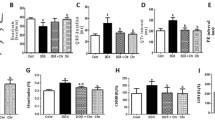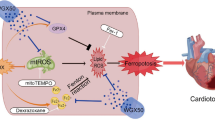Abstract
Heart failure was subsequently noted in 2–4% of patients on bevacizumab (BEV). Whereas mitochondria play an important role in myocardial tissue homeostasis, deterioration in mitochondrial function will eventually lead to cardiomyocyte cell death and consequently cardiovascular dysfunction. Therefore, the aim of our study is to search the effects of BEV on isolated rat heart mitochondria and cardiomyocytes, and survey the effect of curcumin as a mitochondrial protective and cardioprotective agent. Rat heart mitochondria and cardiomyocytes were isolated from adult rat heart ventricular. By using biochemical and flow cytometry evaluations, the parameters of mitochondrial toxicity including succinate dehydrogenase (SDH) activity, mitochondrial swelling, mitochondrial membrane potential (MMP) collapse, reactive oxygen species (ROS) formation and lipid peroxidation (LP), and cellular assays such as cytotoxicity and MMP collapse were evaluated. Results revealed that BEV (up to 50 μg/ml) induced a concentration- and time-dependent rise in mitochondrial ROS formation, MMP collapse, mitochondrial swelling, LP, and inhibition of SDH in rat heart mitochondria. Our results showed that curcumin (10–100 μM) significantly ameliorated BEV-induced mitochondrial toxicities. Also, our results in cellular assays confirmed amelioration effect of curcumin against BEV toxicity. These results indicate that the cardiotoxic effects of BEV are associated with mitochondrial dysfunction and ROS formation, which finally ends in MMP collapse and mitochondrial swelling as the “point of no return” in the cascade of events leading to apoptosis. Also, results of this study suggest that probably the combination therapy of BEV and curcumin could decrease mitochondrial effects of this drug.






Similar content being viewed by others
References
Beach DC, Giroux E (1992) Inhibition of lipid peroxidation promoted by iron (III) and ascorbate. Arch Biochem Biophys 297:258–264
Bhatti JS, Bhatti GK, Reddy PH (2017) Mitochondrial dysfunction and oxidative stress in metabolic disorders—a step towards mitochondria based therapeutic strategies. Biochim Biophys Acta Mol Basis Dis 1863:1066–1077
Biocca S, Ruberti F, Tafani M, Pierandrel-Amaldi P, Cattaneo A (1995) Redox state of single chain Fv fragments targeted to the endoplasmic reticulum, cytosol and mitochondria. Biotechnology 13:1110
Blose SH, Meltzer DI, Feramisco JR (1984) 10-nm filaments are induced to collapse in living cells microinjected with monoclonal and polyclonal antibodies against tubulin. J Cell Biol 98:847–858
Bradford MM (1976) A rapid and sensitive method for the quantitation of microgram quantities of protein utilizing the principle of protein-dye binding. Anal Biochem 72:248–254
Brahmachari G (2017) Cardioprotective natural products: promises and hopes—an overview Cardioprotective natural products: promises and hopes:1
Breininger S, Malcomson F, Afshar S, Turnbull D, Greaves L, Mathers J (2019) Effects of obesity and weight loss on mitochondrial structure and function and implications for colorectal cancer risk. Proc Nutr Soc 78:426–437
Buratti S, Lavine JE (2002) Drugs and the liver: advances in metabolism, toxicity, and therapeutics. Curr Opin Pediatr 14:601–607
Commisso C et al (2013) Macropinocytosis of protein is an amino acid supply route in Ras-transformed cells. Nature 497:633
Correa F et al (2013) Curcumin maintains cardiac and mitochondrial function in chronic kidney disease. Free Radic Biol Med 61:119–129
Deissler HL, Lang GK, Lang GE (2016) Internalization of bevacizumab by retinal endothelial cells and its intracellular fate: evidence for an involvement of the neonatal Fc receptor. Exp Eye Res 143:49–59
Duijnhoven RG, Straus SM, Raine JM, de Boer A, Hoes AW, De Bruin ML (2013) Number of patients studied prior to approval of new medicines: a database analysis. PLoS Med 10:e1001407
Economopoulou P, Kotsakis A, Kapiris I, Kentepozidis N (2015) Cancer therapy and cardiovascular risk: focus on bevacizumab. Cancer Manag Res 7:133
Fiorillo C et al (2008) Curcumin protects cardiac cells against ischemia-reperfusion injury: effects on oxidative stress, NF-κB, and JNK pathways. Free Radic Biol Med 45:839–846
He H et al (2018) Curcumin attenuates doxorubicin-induced cardiotoxicity via suppressing oxidative stress and preventing mitochondrial dysfunction mediated by 14-3-3γ. Food Funct 9:4404–4418
Hosseini M-J, Naserzadeh P, Salimi A, Pourahmad J (2013) Toxicity of cigarette smoke on isolated lung, heart, and brain mitochondria: induction of oxidative stress and cytochrome C release. Toxicol Environ Chem 95:1624–1637
Koch M et al (2017) Threshold analysis and biodistribution of fluorescently labeled bevacizumab in human breast cancer. Cancer Res 77:623–631
Kuppermann B et al. (2013) Effect of bevacizumab (Avastin TM) on mitochondrial function of in vitro retinal pigment epithelial, neurosensory retinal and microvascular endothelial cells
Latvala S, Jacobsen B, Otteneder MB, Herrmann A, Kronenberg S (2017) Distribution of FcRn across species and tissues. J Histochem Cytochem 65:321–333
Lim JP, Gleeson PA (2011) Macropinocytosis: an endocytic pathway for internalising large gulps. Immunol Cell Biol 89:836–843
Lin C-J, Lee C-C, Shih Y-L, Lin C-H, Wang S-H, Chen T-H, Shih C-M (2012) Inhibition of mitochondria- and endoplasmic reticulum stress-mediated autophagy augments temozolomide-induced apoptosis in glioma cells. PloS One 7:e38706
Marschall AL, Dübel S (2016) Antibodies inside of a cell can change its outside: can intrabodies provide a new therapeutic paradigm? Comput Struct Biotechnol J 14:304–308
Mladěnka P et al (2018) Comprehensive review of cardiovascular toxicity of drugs and related agents. Med Res Rev 38:1332–1403
Moghaddam NSA, Oskouie MN, Butler AE, Petit PX, Barreto GE, Sahebkar A (2019) Hormetic effects of curcumin: what is the evidence? J Cell Physiol 234:10060–10071
Morciano G, Giorgi C, Bonora M, Punzetti S, Pavasini R, Wieckowski MR, Campo G, Pinton P (2015) Molecular identity of the mitochondrial permeability transition pore and its role in ischemia-reperfusion injury. J Mol Cell Cardiol 78:142–153
Morén C, Juárez-Flores DL, Cardellach F, Garrabou G (2016) The role of therapeutic drugs on acquired mitochondrial toxicity. Curr Drug Metab 17:648–662
Morin D, Barthélémy S, Zini R, Labidalle S, Tillement J-P (2001) Curcumin induces the mitochondrial permeability transition pore mediated by membrane protein thiol oxidation. FEBS Lett 495:131–136
Müller-Greven G, Carlin CR, Burgett ME, Ahluwalia MS, Lauko A, Nowacki AS, Herting CJ, Qadan MA, Bredel M, Toms SA, Lathia JD, Hambardzumyan D, Sarkaria JN, Hamerlik P, Gladson CL (2017) Macropinocytosis of bevacizumab by glioblastoma cells in the perivascular niche affects their survival. Clin Cancer Res 23:7059–7071
Nabofa WE et al (2018) Cardioprotective effects of curcumin-nisin based poly lactic acid nanoparticle on myocardial infarction in guinea pigs. Sci Rep 8:16649
Nanegrungsunk D et al (2016) Bevacizumab is superior to temozolomide in causing mitochondrial dysfunction in human brain tumors. Neurol Res 38:285–293
Naserzadeh P, Mehr SN, Sadabadi Z, Seydi E, Salimi A, Pourahmad J (2018) Curcumin protects mitochondria and cardiomyocytes from oxidative damage and apoptosis induced by hemiscorpius lepturus venom. Drug Res 68:113–120
Nippert F, Schreckenberg R, Schlüter K-D (2017) Isolation and cultivation of adult rat cardiomyocytes. J Vis Exp 128:1–10
Odinokova I et al (2018) Effect of melatonin on rat heart mitochondria in acute heart failure in aged rats. Int J Mol Sci 19:1555
Onakpoya IJ, Heneghan CJ, Aronson JK (2016) Post-marketing withdrawal of 462 medicinal products because of adverse drug reactions: a systematic review of the world literature. BMC Med 14:10
Orrenius S (2007) Reactive oxygen species in mitochondria-mediated cell death. Drug Metab Rev 39:443–455
Pereira CV, Moreira AC, Pereira SP, Machado NG, Carvalho FS, Sardão VA, Oliveira PJ (2009) Investigating drug-induced mitochondrial toxicity: a biosensor to increase drug safety? Curr Drug Saf 4:34–54
Porporato PE, Filigheddu N, Bravo-San Pedro JM, Kroemer G, Galluzzi L (2018) Mitochondrial metabolism and cancer. Cell Res 28:265
Ramachandran A, Duan L, Akakpo JY, Jaeschke H (2018) Mitochondrial dysfunction as a mechanism of drug-induced hepatotoxicity: current understanding and future perspectives. J Clin Transl Res 28:75–100
Rana P, Aleo MD, Gosink M, Will Y (2018) Evaluation of in vitro mitochondrial toxicity assays and physicochemical properties for prediction of organ toxicity using 228 pharmaceutical drugs. Chem Res Toxicol 32:156–167
Salimi A, Roudkenar MH, Sadeghi L, Mohseni A, Seydi E, Pirahmadi N, Pourahmad J (2016) Selective anticancer activity of acacetin against chronic lymphocytic leukemia using both in vivo and in vitro methods: key role of oxidative stress and cancerous mitochondria. Nutr Cancer 68:1404–1416
Salimi A, Roudkenar MH, Seydi E, Sadeghi L, Mohseni A, Pirahmadi N, Pourahmad J (2017) Chrysin as an anti-cancer agent exerts selective toxicity by directly inhibiting mitochondrial complex II and V in CLL B-lymphocytes. Cancer Invest 35:174–186
Sheu S-S, Nauduri D, Anders M (2006) Targeting antioxidants to mitochondria: a new therapeutic direction. Biochim Biophys Acta Mol Basis Dis 1762:256–265
Sivitz WI, Yorek MA (2010) Mitochondrial dysfunction in diabetes: from molecular mechanisms to functional significance and therapeutic opportunities. Antioxid Redox Signal 12:537–577
Smith DJ, Ng H, Kluck RM, Nagley P (2008) The mitochondrial gateway to cell death. IUBMB Life 60:383–389
Varga ZV, Ferdinandy P, Liaudet L, Pacher P (2015) Drug-induced mitochondrial dysfunction and cardiotoxicity. Am J Physiol Heart Circ Physiol 309:H1453–H1467
Vineeta T, Jaspreet S, Mahaveer G, Santosh K, Arya D (2010) Curcumin protects rat myocardium against isoproterenol-induced ischemic injury: attenuation of ventricular dysfunction through increased expression of Hsp27 along with strengthening antioxidant defense system. J Cardiovasc Pharmacol 55:377–384
Vuda M, Kamath A (2016) Drug induced mitochondrial dysfunction: mechanisms and adverse clinical consequences. Mitochondrion 31:63–74
Ward ES, Martinez C, Vaccaro C, Zhou J, Tang Q, Ober RJ (2005) From sorting endosomes to exocytosis: association of Rab4 and Rab11 GTPases with the Fc receptor, FcRn, during recycling. Mol Biol Cell 16:2028–2038
Will Y, Dykens J (2014) Mitochondrial toxicity assessment in industry–a decade of technology development and insight. Taylor & Francis,
Wongcharoen W, Phrommintikul A (2009) The protective role of curcumin in cardiovascular diseases. Int J Cardiol 133:145–151
Xu P, Yao Y, Guo P, Wang T, Yang B, Zhang Z (2013) Curcumin protects rat heart mitochondria against anoxia–reoxygenation induced oxidative injury. Can J Physiol Pharmacol 91:715–723
Zang QS, Wolf SE, Minei JP (2014) Sepsis-induced cardiac mitochondrial damage and potential therapeutic interventions in the elderly. Aging Dis 5:137
Acknowledgments
The data provided in this article was extracted from the Pharm D. thesis of Dr. Nima Shokouhi Sabet. The thesis was conducted under supervision of Dr. Ahmad Salimi at the Department of Pharmacology and Toxicology, School of Pharmacy, Ardabil University of Medical Sciences, Ardabil, Iran. This study was supported by Ardabil of Medical Sciences, Deputy of Research.
Author contribution statement
AS conceived and designed the research, analyzed the data, and wrote the manuscript. NS, SA, and EM conducted the experiments. FK contributed new reagents or analytical tools. All authors read and approved the manuscript.
Author information
Authors and Affiliations
Corresponding author
Ethics declarations
This study was approved by the Ethics Committee at the Ardabil University of Medical Sciences with ethics code IR.ARUMS.REC.1397.293, and performed strictly in accordance with institutional and international guide for animal care.
Conflict of interest
The authors declare that they have no conflict of interest.
Additional information
Publisher’s note
Springer Nature remains neutral with regard to jurisdictional claims in published maps and institutional affiliations.
Rights and permissions
About this article
Cite this article
Sabet, N.S., Atashbar, S., Khanlou, E.M. et al. Curcumin attenuates bevacizumab-induced toxicity via suppressing oxidative stress and preventing mitochondrial dysfunction in heart mitochondria. Naunyn-Schmiedeberg's Arch Pharmacol 393, 1447–1457 (2020). https://doi.org/10.1007/s00210-020-01853-x
Received:
Accepted:
Published:
Issue Date:
DOI: https://doi.org/10.1007/s00210-020-01853-x




